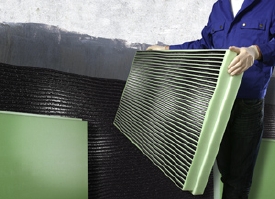Oct 30 2008
For insulating buildings exposed to groundwater with Styrodur® C, BASF’s green extruded polystyrene rigid-foam panels (XPS), BASF subsidiary PCI Augsburg has recently developed PCI Pecimor DK, a water-repellant adhesive.

This adhesive, which hardens quickly without releasing water, can be applied to the entire surface of the insulating panels. The function of the insulation is ensured along the perimeter, even in the case of temporary or permanent exposure to pressing water since the water cannot penetrate behind the insulation. This means that basements can be better protected against mold growth.
Basements whose outer walls are exposed to groundwater have to be thermally insulated. If left without insulation, the walls cool off so drastically that condensation forms on the inner surface for prolonged periods of time. Such basements cannot be properly utilized without thermal insulation. Mold can grow not only on the walls but also on articles stored in the basement. Thanks to their good thermal insulation capacity, high compressive strength and low water absorption, Styrodur C panels lend themselves for perimeter insulation in groundwater.
The PCI Pecimor DK adhesive is solvent-free. It consists of three parts by weight of a liquid component made of a polymer-bitumen emulsion and one part of a cement-based powder component. After being mixed, the adhesive can be processed for 60 to 80 minutes, preferably at about 23°C [73.4°F] and 50% relative humidity. Conceivable substrates for such adhesives are structurally dense concrete, plaster belonging to mortar groups P II or P III, masonry laid according to DIN 1053 and made of bricks, sand lime bricks, light-concrete blocks and concrete hollow blocks, porous concrete or surfaces sealed with a heavy bitumen coating. Once the primer has dried, the Styrodur C insulating panels can be glued the very next day. Below the groundwater level, the adhesive has to be applied over the entire surface, while above the groundwater level, a spot gluing technique suffices.